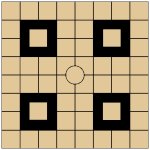BeeTee
Handloader
- Jul 27, 2011
- 400
- 0
Seems to me that the target has a lot to do with accuracy. For example, the "sight-in" targets used at & sold by ranges are fine for sighting in, but seeing a precise aiming point isn't a sight-in target's strong point. Most times good enough, but...
Quite some years ago I began experimenting with an old Leupold target that was printed on light beige card stock, having four 2" black squares on the grid. With my 223, I found that by glueing on a beige 1" square in the exact center of the 2" black square, I could better align my 12x fine duplex. The non-reflective beige paper works better than stark white. Your eyes are quite good at using the crosshairs to split the difference when it's a square. Circles aren't that great.
I can't locate any more of those Leupold targets, so I began making my own... I use the 8-1/2" x 11" non-glossy card stock bought from Staples. If you can get beige, use that, or white if you have a color printer to reproduce the beige. Size the print to produce exactly 2" squares with the 1" grid. If you have a target rifle with a high power scope, cut the size by half.
If your rifle prints just above the black square, you essentially have 8 targets. Just rotate it. I do that a lot. BT
Quite some years ago I began experimenting with an old Leupold target that was printed on light beige card stock, having four 2" black squares on the grid. With my 223, I found that by glueing on a beige 1" square in the exact center of the 2" black square, I could better align my 12x fine duplex. The non-reflective beige paper works better than stark white. Your eyes are quite good at using the crosshairs to split the difference when it's a square. Circles aren't that great.
I can't locate any more of those Leupold targets, so I began making my own... I use the 8-1/2" x 11" non-glossy card stock bought from Staples. If you can get beige, use that, or white if you have a color printer to reproduce the beige. Size the print to produce exactly 2" squares with the 1" grid. If you have a target rifle with a high power scope, cut the size by half.
If your rifle prints just above the black square, you essentially have 8 targets. Just rotate it. I do that a lot. BT





